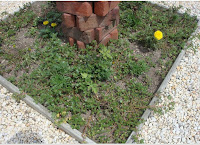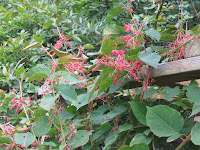“A plant in the wrong place” is probably the best thumbnail description of a weed I’ve come across, avoiding as it does the whole value-judgment, hierarchical, holier-than-thou vortex. Let’s put this weed identification series to rest by looking at some plants that flummox any such neat categorization attempts.
I’ll provide minimal commentary. You judge for yourself. There are no right answers.
WILDFLOWERS
Here are nine specimens that grow wild—meaning without any initiation or intervention from me—in our yard or in the vacant lot next door. Most are well-behaved, and stick to their niches. Usually. (Click on the pictures to enlarge them.)
 Bushy aster (Aster dumosus)
Bushy aster (Aster dumosus)
 Bushy aster (Aster dumosus)
Bushy aster (Aster dumosus)I like this white-blooming perennial, but have a soft spot (and a collector’s eye) for all asters. I’ll probably do a whole post on the genus come September. But I won’t call them Symphyotrichum, even if the Taxonomy Police show up at our front door.
In my book, most members of the leguminous Fabaceae (pea) family are garden-worthy. This one’s quirky beauty has to seen up close to be appreciated.
A classic fall perennial, and with good reason. The wild version flowers more prolifically and returns more reliably than any hybrid I’ve tried.
Blooming from early to mid-spring, annual evening primrose’s cup-shaped lemon-yellow flowers are a welcome sight. But I wouldn’t have its pushy pink perennial cousin, showy evening primrose (O. speciosa), in my garden on a bet.
Prickly pear cactus (Opuntia humifusa)
Cactus aren’t my thing, even perennial natives like prickly pear. The leaves—because that’s what the pads are—don’t rock my boat. But I waver when flowers and fruit appear. Still, not a good choice for barefoot gardeners.
Purslane (Portulaca oleracea)
Succulent purslane is the wild cousin of the highly hybridized bedding plant, portulaca. Both are annual; purslane is by far more understated. Thanks to my friend, Chuck, for the picture of his marigolds overtaken by a stand of purslane.
 |
| Marigolds overrun by purslane |
 |
| Understated purslane flower |
This native relation of Chinese Lespedeza thunbergii (see “Enter Field Notes,” posted June 12, 2011) produces poufs of white-and-lavender flowers in its leaf axils beginning in late summer. Personally, I’m a fan of all things lespedeza.
Sunny annual cousin to the many hybridized sneezeweeds. Clumps of low-growing, taprooted, golden yellow flowers appear on road verges in July, and continue blooming into October most years.
This evergreen native vine threads its way up trees, cunningly climbs fence posts and snakes along the ground for hundreds of yards (it seems). I snip off terminal ends and pull out runners that make forays into my yard, but glory in the cascades of yellow trumpet flowers produced in late winter and early spring in the vacant lot adjoining our property.
WILD FLOWERS
Moving right along, I offer eight cultivated perennials that have weed/wildflower parents whose wild origins and habits have not been reliably overcome.
You can generally count on coreopsis hybrids to be well-behaved, but watch out for the straight species. My experience has been that their seed-germination rate is in excess of 100%.
Bee balm (Monarda didyma)
Whiskery flowered bee balms and their cousins, the eastern horsemints (M. punctata var. punctata), have well-deserved reputations for spreading by rhizome far beyond their allotted spots in gardens. At least you can contain them by planting in sunken pots.
 |
| Eastern horsemint, a.k.a. wild bergamot |
 |
| Monarda didyma, parent of most ornamental bee balms |
A perennial lookalike of annual floss flower, this autumnal blue-bloomer also spreads aggressively by rhizome, something I didn’t know until its second season in my garden. Took me two more years of grubbing out shoots to eradicate it completely.
Spiderwort’s another candidate for planting in a pot to contain its propensity to wander. The volunteer shown here descended from a gold-foliaged T. x andersoniana ‘Sweet Kate’ that reverted to its T. virginiana parent-type. It’s nowhere near the original plant.
This sweet blue flower hides a megalomaniacal secret: it’s out to conquer the world by seed as well as rhizome. After six years of trying to keep it where I wanted it to stay, I’ve given up and let it naturalize throughout the yard.
This clump-forming thug came home with me, at great cost, from one of Plant Delights Nursery’s Open Houses. I keep it in bounds (barely) by whacking at it constantly during the growing season, using lots of masons twine, and trying to remember to deadhead before seed-set. Why do I keep it? Tim loves the flowers.
This smothering native beauty grows with wild abandon in the woods and waste places of southeastern North Carolina; but every ‘Madame Galen’ hybrid I’ve planted on purpose has died. It’s comforting, in a way, to have proof that not everything bends to man’s will.
Maypop (Passiflora incarnata)
I have to confess that I love this native annual vine. Like wisteria, to me it’s worth the trouble it causes. But if you opt to install passionflower in your yard, you should know I’ve pulled up 175 volunteer seedlings so far this season, mostly from our yard, but also from the neighbors’. Don’t say I didn’t warn you.
 |
| Why I put up with maypop |
 |
| Three of this year's 175 seedlings (and counting) |
Okay, kids, I’m tired of talking (and talking and talking) about weeds for a while. I know there's a useful book in all this verbiage: nonetheless, we’ll change the subject next time.
Thanks for dropping by.
Kathy













